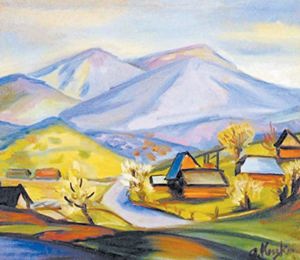Reflective landscape and psychological portrait

Recently it was the 100th anniversary of the great artist Andrii Kotska’s birthday. During his life he gained European fame and recognition. However, this did not save him from the “clutches” of Soviet power. Kotska never was a “court” artist but he still had to compromise in some things.
Portraits of Hutsul girls and girls from Verkhovyna were Kotska’s hallmark. Kotska, a brilliant student of Adalbert Erdeli, had to overcome many obstacles on the way to the Olympus of Great Art. The future artist met his teacher in Uzhhorod Choristers and Teachers Seminary, where Erdeli taught graphics. Erdeli’s influence turned to be so powerful that even at that time young Kotska made a firm decision to become an artist.
Studying in the Public School of Art from famous masters of painting Erdeli and Yosyp Bokshai, persistent and inspired work on self-development produced good results. In 1931 Kotska successfully graduated from the Seminary and begins working as a teacher in the village of Tykhe in Verkhovyna. Later he served in Czechoslovak Army in the rank of lieutenant in the cavalry. Upon his return he continued working as a teacher in the village in the Carpathians.
Artist’s favorite characters were his students and residents of Tykhe. As Kotska’s fellow artist mention, he was fond of feminine beauty, therefore, it is no coincidence that image of a girl from Verkhovyna has the central position in his work. Art critic Volodymyr MYSHANYN from Uzhhorod believes that the main creative achievement of Kotska was his constant and persistent searching for and, finally, finding the perfect image of the Carpathian woman.
Works by the master from the 1930s became a remarkable event in the Transcarpathian painting of that time. In 1933 a solo exhibition of Kotska’s and Adalbert Boretsky’s works was held and public warmly welcomed it. Two years later another solo exhibition was opened. It also had a great success and consolidated its author a reputation of one of the most talented painters of Transcarpathia. According to the results of the All-Hungarian Art Exhibition held in 1939 Kotska was awarded a scholarship to study at the Academy of Fine Arts in Rome under the supervision of Professor Ferrucio Ferrazzi.
For Kotska plastic and graphic theme solutions always come first, and yet he is a portraitist. He showed hidden features of human personalities in every of his paintings. However, Kotska also worked a lot as a landscape painter, who had a fine appreciation of beauty and uniqueness of Transcarpathia. Here he is a lyric artist first of all, attracted to the great scale, but in every landscape he puts pure emotions and deep personal reflection.
Notably, Kotska has always been in the epicenter of cultural and artistic life during both prewar and postwar periods. That is well understandable, because his closest associates were Erdeli, Bokshai, Ernest Kontratovych, Fedir Manailo, and other legendary artists. Kotska was a member of the Society of Fine Arts in Subcarpathian Rus’ since 1933. In 1946 he became one of the founders of the newly formed Transcarpathian Union of Artists of Ukraine and one of the first teachers at Uzhhorod College of Art and Industry. In 1944 and 1945 the artist even was the head of Uzhhorod People’s Militia created by Soviet authorities.
With each year the price for Kotska’s canvases grow with incredible speed. Only in the latest three years they have grown by more than 100 percent reaching tens of thousands of hryvnias. In 2007 five of his works were stolen from the museum in Uzhhorod and from several private collections. Unfortunately, the originals are still not found. For several years Kotska firmly remains in the top five of the most expensive artists of Transcarpathia. His canvases don’t stay long in Uzhhorod galleries and change residence to Kyiv. It is both joyful and sad. Because, as experience shows, a lot depends on the owners, who get artistic gems in their personal use – it is also true about works of the unique artist Kotska.
Newspaper output №:
№67, (2011)Section
Time Out





